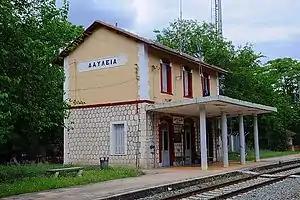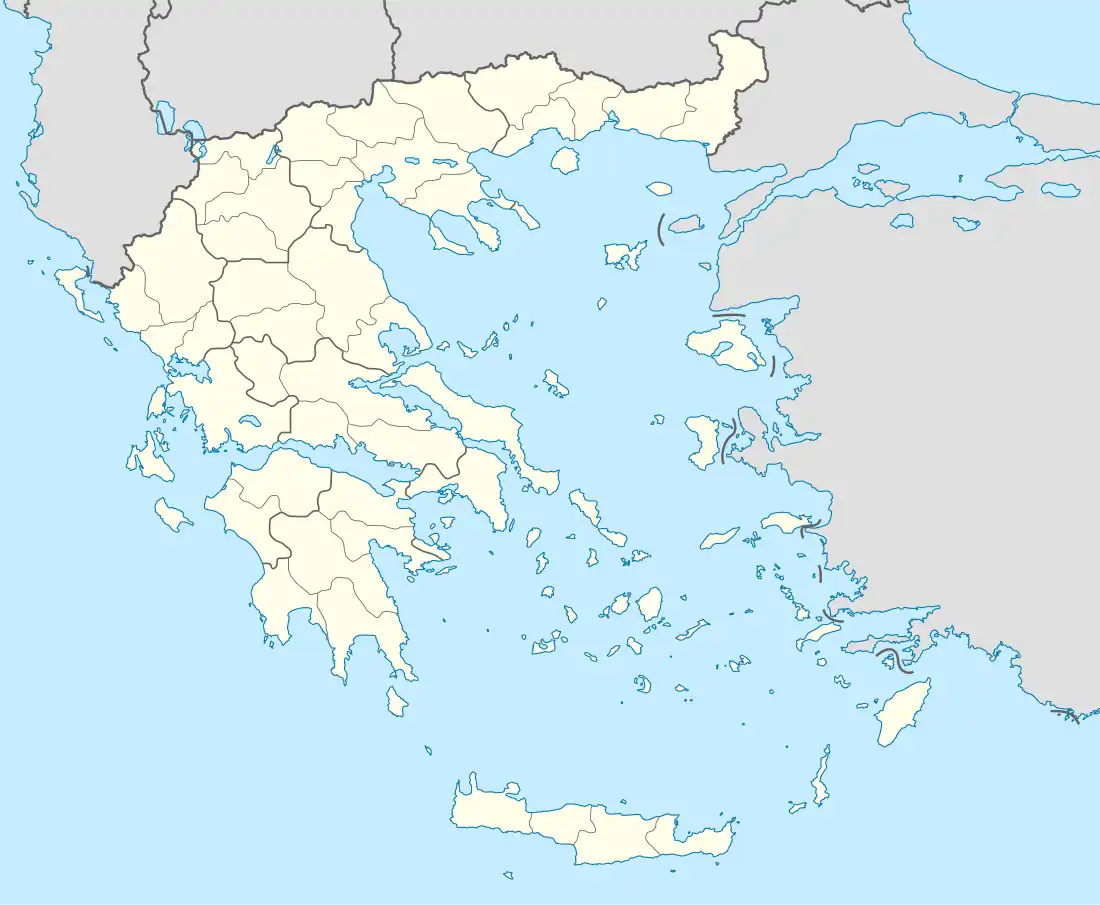Davleia railway station
Davleia railway station (Greek: Σιδηροδρομικός Σταθμός Δαυλείας, romanized: Sidirodromikós stathmós Davleias) is a railway station situated 8.3 kilometres (5.2 mi) north of Davleia, Greece, despite its name, the station is closer to the settlement of Mavroneri. The station opened on 11 November 1904. It is served by local trains to Athens and Leianokladi.[4]
Δαύλεια Davleia | |||||||||||
|---|---|---|---|---|---|---|---|---|---|---|---|
 Davleia railway station, May 2011 | |||||||||||
| General information | |||||||||||
| Location | Davlia Livadeia Greece | ||||||||||
| Coordinates | 38°32′03″N 22°48′44″E | ||||||||||
| Owned by | GAIAOSE[1] | ||||||||||
| Line(s) | Piraeus–Platy railway[2] | ||||||||||
| Platforms | 2 | ||||||||||
| Tracks | 2 | ||||||||||
| Train operators | Hellenic Train | ||||||||||
| Construction | |||||||||||
| Structure type | at-grade | ||||||||||
| Platform levels | 1 | ||||||||||
| Parking | No | ||||||||||
| Bicycle facilities | No | ||||||||||
| Other information | |||||||||||
| Website | http://www.ose.gr/en/ | ||||||||||
| History | |||||||||||
| Opened | 8 March 1904[3] | ||||||||||
| Electrified | 25 kV AC, 50 Hz[2] | ||||||||||
| Services | |||||||||||
| |||||||||||
| Location | |||||||||||
 Davleia Location within Greece | |||||||||||
History
The station opened on 11 November 1904.. In 1920 Hellenic State Railways or SEK was established, and the line became part of the network. During the Axis occupation of Greece (1941–44), Athens was controlled by German military fourses, and the line used for the transport of troops and weapons. During the occupation (and especially during the German withdrawal in 1944), the network was severely damaged by both the German army and Greek resistance groups. The track and rolling stock replacement took time following the civil war, with normal service levels resumed around 1948.
In 1970 OSE became the legal successor[5] to the SEK, taking over responsibilities for most of Greece's rail infrastructure. On 1 January 1971, the station and most of the Greek rail infrastructure were transferred to the Hellenic Railways Organisation S.A., a state-owned corporation. Freight traffic declined sharply when the state-imposed monopoly of OSE for transporting agricultural products and fertilisers ended in the early 1990s. Many small stations of the network with little passenger traffic were closed down. It was during this time that bus-like shelters were installed on both platforms.
In 2001 the infrastructure element of OSE was created, known as GAIAOSE; it would henceforth be responsible for the maintenance of stations, bridges and other elements of the network, as well as the leasing and the sale of railway assists.[1] In 2005, TrainOSE was created as a brand within OSE to concentrate on rail services and passenger interface. In 2009, with the Greek debt crisis unfolding OSE's Management was forced to reduce services across the network.[6] Timetables were cutback and routes closed, as the government-run entity attempted to reduce overheads. In 2017 OSE's passenger transport sector was privatised as TrainOSE, (Now Hellenic Train) currently, a wholly-owned subsidiary of Ferrovie dello Stato Italiane[7] infrastructure, including stations, remained under the control of OSE. In July 2022, the station began being served by Hellenic Train, the rebranded TranOSE.[8]
Facilities
The station is still housed in a 20th-century brick-built station building, but this is now in disrepair. The Station is currently (2022) not equipped with toilets or a staffed ticket office. Access to the platforms is via crossing the lines. At platform level, there are sheltered seating but no Dot-matrix display departure or arrival screens or timetable poster boards on all platforms. Currently, there is no local bus stop connecting the station.
Services
It is served by Regional services between Athens and Leianokladi.[9] The station sees around 2 trains per-day.
Station layout
| Ground level | Customer service | Exit/Tickets |
| Level Ε1 |
Side platform, doors will open on the right | |
| Platform 1 | ||
| Platform 2 | ||
| Side platform, doors will open on the right | ||
References
- "Home". gaiaose.com (in Greek).
- "OSE - 2017 Network Statement Annexes". Archived from the original on 8 July 2017.
- "Ο Σιδηροδρομικός Σταθμός Λειανοκλαδίου το 1965. Βίντεο" (in Greek). 12 May 2021.
- TrainOSE 2013 timetable Archived 2013-01-19 at the Wayback Machine
- Law 674/1971, Government Gazette A-192/1970
- "Σιδηροδρομικός σταθμός - Μουσείο τρένων" (in Greek).
- "It's a new day for TRAINOSE as FS acquires the entirety of the company's shares". ypodomes.com. Retrieved 14 September 2017.
- "TrainOSE renamed Hellenic Train, eyes expansion". Kathimerini. 2 July 2022. Archived from the original on 2 July 2022.
- TrainOSE 2013 timetable Archived January 19, 2013, at the Wayback Machine
External links
- Davleia railway station - National Railway Network Greek Travel Pages